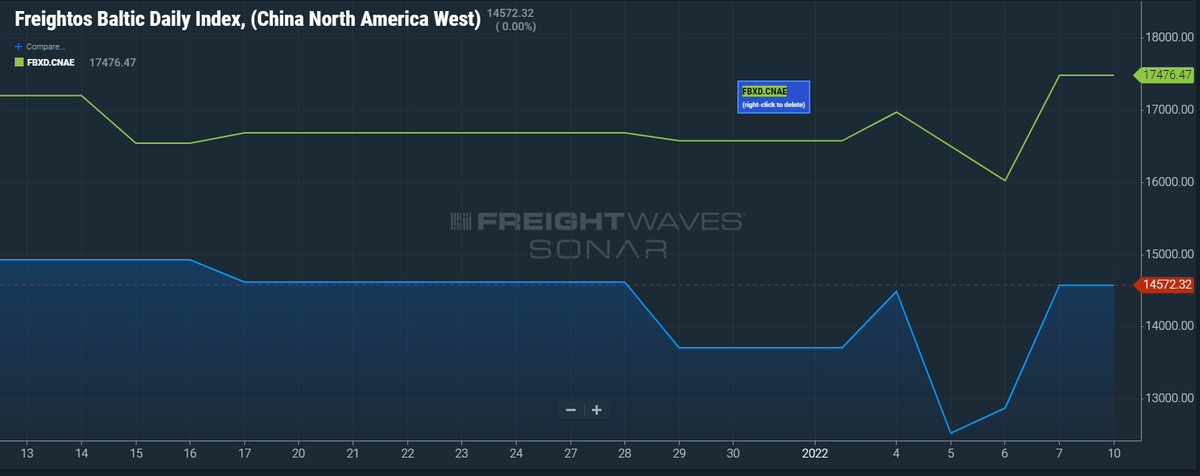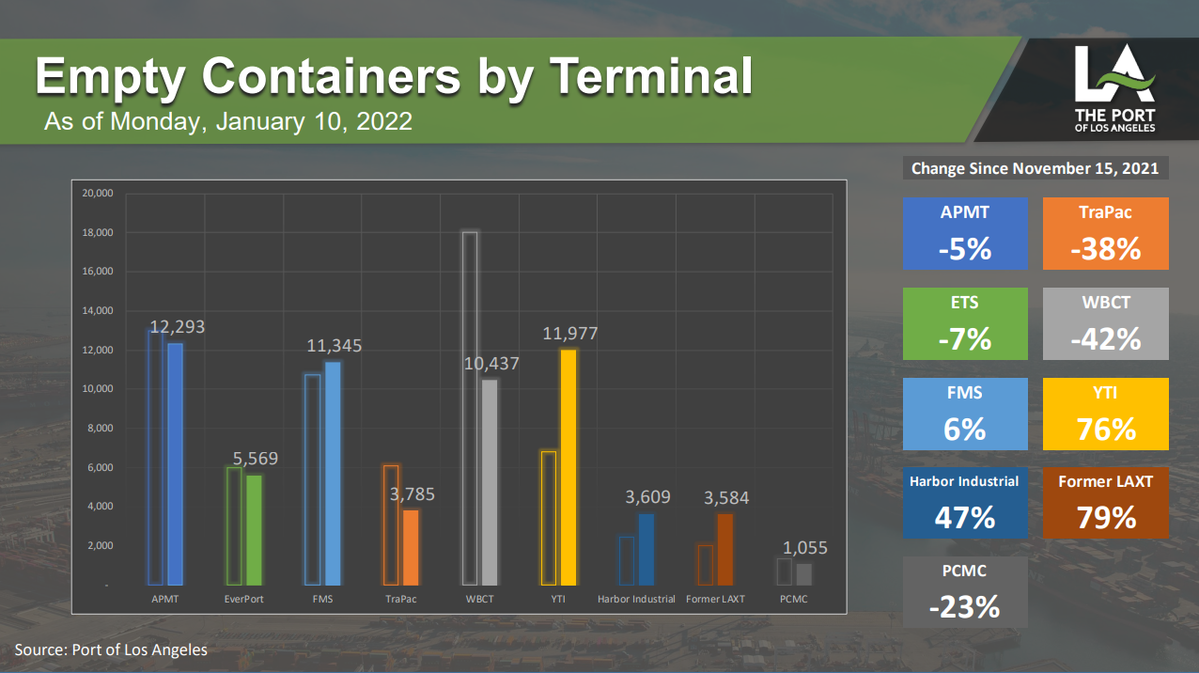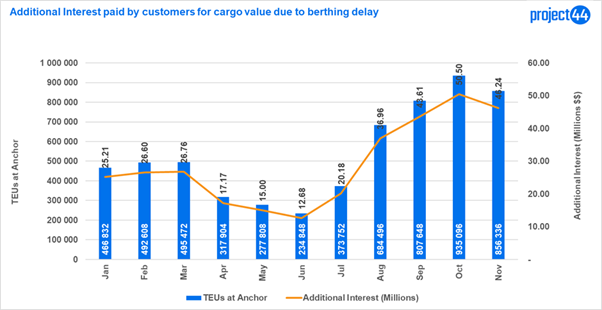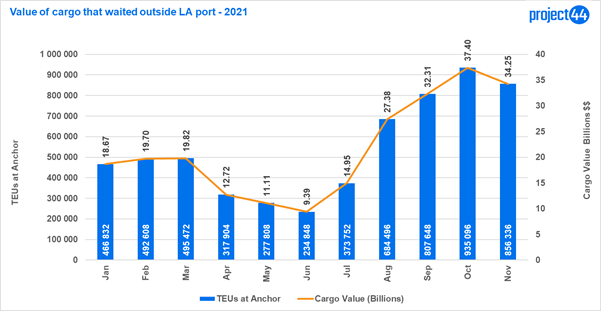The inverse relationship between the price tag of trade and overall service continues to be upside down — and don’t expect that trend to change anytime soon.
Despite the rhetoric, the historic amount of imports from Asia is canceling any reported “success” of long-dwelling containers being moved out of the Port of Los Angeles. Executive Director Gene Seroka tells American Shipper that the port’s land capacity remains at 100%. Ideally, that percentage should be in the 70s for efficient container transport.
“We’re underutilizing opportunities to move containers off our docks,” Seroka explained. “We dug into our data and unused truck appointments have jumped from 30% in the summer to 55%. Chassis are tied up on the street for 11 days. The dwell time for import containers in the terminals is six days.
“Meanwhile, rail providers have 40% excess capacity now. We need to do much better using our rail assets.”
In the chart below, the empty rectangles represent the available truck appointments. The solid rectangles represent fulfilled appointments.

The finger-pointing of blame and the political promises and suggestions are not improving the flow of trade.
The reality of this is clear — until the ocean carriers, terminals, warehouses and truckers put everything aside and are honest about how to rectify the situation, trade will continue to move at the pace of a sloth.
This port blame game is prohibiting the advancement in the movement of trade. The vessel congestion and its impact on safety and air quality in the San Pedro Bay area have led to new queuing measures that have lengthened the timeline of transit.
Freightos.com data shows the average monthly end-to-end transit time for China-U.S. ocean shipments hit a record of 80 days in December.

Here’s what it shows: 50% longer than in December 2020 and 85% longer than in 2019.
The Asia to West Coast rate is 169% higher than the same time last year. Asia-U.S. East Coast prices climbed 6% to $17,476 per forty-foot equivalent unit and are 190% higher than rates for this week last year.

Trade at rest is not making money.
All pieces of a port need to be at optimum levels for vessels to move in and out efficiently. The biggest hurdle to the flow of trade out of the ports of Los Angeles and Long Beach is the fact they are landlord ports.
Two land stakeholders in particular, the terminals and chassis operators, have agreements with the ocean carriers on everything from the amount of container “free time” importers can have at the port (which adds to the land capacity problem) as well as the restrictions on chassis and empty container (which dictate what type of container can be picked up or dropped off).
Until the ocean carriers modify these agreements, congestion and finger-pointing will continue among the trucking industry. Factor in the lack of warehouse workers and automation and it’s a trade cement cocktail.
This can easily be tracked by MarineTraffic in the increased times a vessel is at port.
While the entrance of smaller container vessels calling the Port of LA has decreased the amount of TEUs being processed at the port, it has not helped the port carve out more efficiency. Chassis are cemented down outside of the port. Based on the dwell times of chassis at terminals and on the street, chassis are in container purgatory.

The latest effort by the Port of LA to free up land capacity is the threat of charging ocean carriers a fee on long-dwelling empty containers. Some improvement is being recorded — but, again, the port is still at 100% capacity.
In the chart below, the empty rectangle represents the empty container levels back on Nov. 15. The solid rectangle represents the current amount.

What we are seeing here is the equivalent of trying to dig a hole in quicksand. The container volume coming in is wiping out any “gains” in containers moving out.
The Pacific Maritime Association tells American Shipper, “The historic supply chain congestion is highlighting the vital role that West Coast ports play in America’s economy and reinforcing the importance of every link in our supply chain: warehouses, trucks, trains, truck chassis and other vital equipment, in addition to marine terminals.
“Each of these elements must operate efficiently and in concert, with a sufficient workforce, in order to bring relief to the congestion that is slowing goods movement across the country.”
So what does this lack of productivity mean for the supply chain? Inflation.
Importers are paying more for horrible service and for those borrowing, the interest they are paying on these products is passed onto the consumer fueling inflation.
Based on shipping and logistics visibility company project44’s breakdown on an average cargo value of $40,000 per twenty-foot equivalent unit out of the Port of Los Angeles, shippers found themselves paying around $106 per TEU per month against a 3.2% cost of financing.

A breakout of the project44’s data shows an average of 540,255 TEUs per month waited outside the Port of Los Angeles in 2021 with an average of 377 container ships per month waiting at anchorage for a berth.

Another troubling trend of container movement out of the Port of LA is the increased dwell time of U.S. export containers. The increase in dwell time is a physical reminder of ocean carriers taking empty containers over U.S. exports.

U.S. exports have hit a 17-year low out of the Port of Los Angeles, yet empty containers being exported have increased. This is a direct result of the ocean carriers’ trade decisions. It is another monetary lever in the flow of trade that is gummed up and it won’t be freed up until the ocean carriers start accepting the exports on a timely basis.
Instead, we have heard praise from the Biden administration on the Port of Oakland opening a new container yard for agricultural exports to access empty containers to use for exports. Los Angeles is expected to have a similar measure.
“We are working with industry to look at all export opportunities and make use of the numerous empty containers on our marine terminals,” said Seroka. “U.S. exporters need to have access to containers so they can move their product. The next step is to align with service providers on a geography-based approach.”
But the reality of this solution is this: No matter how many opportunities the ports along the West Coast give to the agriculture industry for empty containers so they can be billed, it does not mean they will be exported.
The ocean carriers need to accept those exports on their vessels. Based on the historic flow of U.S. exports, which is controlled by the foreign-owned ocean carriers, the track record speaks for itself. The decrease in U.S. exports out of the country’s largest port is a glaring reminder of the trade being rolled over.
While these additional containers being made available is being hailed by the Biden administration as a win for the agriculture industry, it is nothing but empty political rhetoric until the ocean carriers place the boxes on their vessels.
In order for the landlord ports of LA and Long Beach to run efficiently, every single trade participant must sit at the table and agree to take action and work at 100%. The finger-pointing must stop.
It has been known now for well over a year U.S. importers are not getting what they pay for. Some trade participants are making money hand over fist. U.S. trade is being held hostage and importers’ purse strings have lost all elasticity.
There needs to be accountability. Not political rhetoric backslapping. Containers don’t lie.



Virginia Porter
Makes 💵$340 to 💵$680 per day online work and I received 💵$21894 in one month online acting from home. I am a daily student and work simply one to a pair of hours in my spare time. Everybody will do that job and online ask extra cash by simply
copy and open this site .…………>> 𝗪𝘄𝘄.𝗡𝗘𝗧𝗖𝗔𝗦𝗛𝟭.𝗖𝗼𝗺